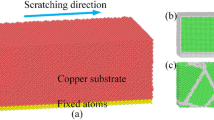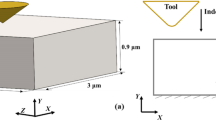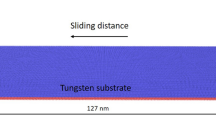Abstract
The process of material removal of single crystal copper with rough surfaces subjected to nanoscale scratching is studied in the present paper. We explore the key material removal mechanism by means of the observed variation of material removal under different surface roughnesses, tool speeds, scratching directions, tip shapes, feeds, double tip, and single tip. The investigation reveals that a higher peak on the surface reduces the local area roughness, and a higher valley enhances the stability of surface structure. The plastic deformation by means of dislocation loop transfers from the surface of substrate to the interior of workpiece with the rough or smooth surface during scratching process. A higher scratching velocity results in the increasing surface smoothness and reducing the impact on the rough surface atoms. The scratching along the critical angle 45° between scratching direction and surface texture orientation makes the surrounding atoms produce the minimal variation structure, helps to improve the structural stability, and plays an important role in protecting the scratching surface. The double-tip and single-tip scratching under different scratching feeds makes the rough surface perpendicular to the scratching direction substantially covered by chips or side flow. For different tip shapes, a cone diamond tip causes less plastic deformation in the subsurface than a prismatic diamond tip due to using different diamond tips with a contact area unequal.
Similar content being viewed by others
References
Zhang LC, Biddut AQ, Ali YM (2010) Dependence of pad performance on its texture in polishing mono-crystalline silicon wafers. Int J Mech Sci 52:657–662
Xu W, Zhang LC, Wang X (2013) Laser bending of silicon sheet: absorption factor and mechanisms. J Manuf Sci Eng 135:061005–061011
Menezes PL, Kishore KSV (2006) Studies on friction and transfer layer: role of surface texture. Tribol Lett 24:265–273
Lee H, Bhushan B (2011) Role of surface roughness and lubricant film thickness in nano lubrication of sliding components in adaptive optics. J Colloid Interface Sci 353:574–581
Zhao WJ, Wang LP, Xue QJ (2010) Design and fabrication of nanopillar patterned Au textures for improving nanotribological performance. ACS Appl Mater Interfaces 2:788–794
Zhang X, Zhong X, Meng X, Yi G, Jia J (2012) Adhesion and friction studies of nano-textured surfaces produced by self-assembling Au nanoparticles on silicon wafers. Tribol Lett 46:65–73
Urbakh M, Klafter J, Gourdon D, Israelachvili J (2004) The nonlinear nature of friction. Nature 430:525–528
Wang H, Nair RP, Zou M, Larson PR, Pollack AL, Hobbs KL, Johnson Mathew Band Awitor OK (2007) Friction study of a Ni nanodot-patterned surface. Tribol Lett 28:183–189
Akarapu S, Sharp T, Robbins MO (2011) Stiffness of contacts between rough surfaces. Phys Rev Lett 106:204301–204304
Pohrt R, Popov VL (2012) Normal contact stiffness of elastic solids with fractal rough surfaces. Phys Rev Lett 108:104301–104304
Sharifi-Mood N, Koplik J, Maldarelli C (2013) Molecular dynamics simulation of the motion of colloidal nanoparticles in a solute concentration gradient and a comparison to the continuum limit. Phys Rev Lett 111:184501–184505
Zhou K, Nazarov AA, Wu MS (2007) Competing relaxation mechanisms in a disclinated nanowire: temperature and size effects. Phys Rev Lett 98:035501–035504
Zhou K, Nazarov AA, Wu MS (2006) Continuum and atomistic studies of a disclinated crack in a bicrystalline nanowire. Phys Rev B 73:045410–045410
Zhou K, Wu MS, Nazarov AA (2008) Relaxation of a disclinated tricrystalline nanowire. Acta Mater 56:5828–5836
Kuo CG, Chao CG (2007) A novel method of centrifugal processing for the synthesis of lead–bismuth eutectic alloy nanospheres and nanowires. Int J Adv Manuf Technol 32:468–472
Zhou K, Nazarov AA, Wu MS (2008) Atomistic simulations of the tensile strength of a disclinated bicrystalline nanofilm. Philos Mag 88:3181–3191
Zhang LC, Tanaka H (1997) Towards a deeper understanding of wear and friction on the atomic scale—a molecular dynamics analysis. Wear 211:44–53
Sun XZ, Cheng K (2010) Multi-scale simulation of the nano-metric cutting process. Int J Adv Manuf Technol 47:891–901
Zhu P, Hu Y, Fang F, Wang H (2012) Multiscale simulations of nanoindentation and nanoscratch of single crystal copper. Appl Surf Sci 258:4624–4631
Chen W, Liang Y, Luo X, Sun Y, Wang H (2014) Multi-scale surface simulation of the KDP crystal fly cutting machining. Int J Adv Manuf Technol 73:289–297
Tong Z, Liang Y, Jiang X (2014) An atomistic investigation on the mechanism of machining nanostructures when using single tip and multi-tip diamond tools. Appl Surf Sci 290:458–465
Tong Z, Liang Y, Yang X, Luo X (2014) Investigation on the thermal effects during nanometric cutting process while using nanoscale diamond tools. Int J Adv Manuf Technol:1–10
Xu W, Zhang LC (2014) On the mechanics and material removal mechanisms of vibration-assisted cutting of unidirectional fibre-reinforced polymer composites. Int J Mach Tools Manuf 80:1–10
Ji C, Shi J, Wang Y, Liu Z (2013) A numeric investigation of friction behaviors along tool/chip interface in nanometric machining of a single crystal copper structure. Int J Adv Manuf Technol 68:365–374
Han X, Gan YX (2013) Investigation the complex dynamic evolvement mechanism of particle cluster and surface integrity in the chemical mechanical planarization. Int J Adv Manuf Technol 64:13–22
Alao AR, Konneh M (2012) Surface finish prediction models for precision grinding of silicon. Int J Adv Manuf Technol 58:949–967
Zhang Z, Huo F, Wu Y, Huang H (2011) Precision grinding of silicon wafers using an ultrafine diamond wheel of a hybrid bond material. Int J Mach Tools Manuf 51:18–24
Zhang Z, Song Y, Xu C, Guo D (2012) A novel model for undeformed nanometer chips of soft-brittle HgCdTe films induced by ultrafine diamond grits. Scr Mater 67:197–200
Zhang Z, Xu C, Zhang X, Guo D (2012) Mechanical characteristics of nanocrystalline layers containing nanotwins induced by nanogrinding of soft-brittle CdZnTe single crystals. Scr Mater 67:392–395
Zhang Z, Huo F, Zhang X, Guo D (2012) Fabrication and size prediction of crystalline nanoparticles of silicon induced by nanogrinding with ultrafine diamond grits. Scr Mater 67:657–660
Chen Y, Zhang LC (2009) Polishing of polycrystalline diamond by the technique of dynamic friction part 4: establishing the polishing map. Int J Mach Tools Manuf 49:309–314
Chen Y, Zhang LC, Tang F (2012) Surface integrity of PCD composites generated by dynamic friction polishing: effect of processing conditions. Diam Relat Mater 26:25–31
Li J, Fang QH, Liu YW, Zhang LC (2014) A molecular dynamics investigation into the mechanisms of subsurface damage and material removal of monocrystalline copper subjected to nanoscale high speed grinding. Appl Surf Sci 303:331–343
Zhang Z, Zhang N, Ma G, Kang R (2013) Characterization of microstructural stability for nanotwinned mercury cadmium telluride under cyclic nanoindentations. Scr Mater 69:299–302
Zhang Z, Wang B, Zhang X (2014) A maximum in the hardness of nanotwinned cadmium telluride. Scr Mater 72:39–42
Foiles SM, Baskes MI, Daw MS (1986) Embedded-atom method functions for the fcc metals Cu Ag Au Ni Pd Pt and their alloys. Phys Rev B 33:7983–7991
Pei QX, Lu C, Lee HP (2007) Large scale molecular dynamics study of nanometric machining of copper. Comput Mater Sci 41:177–185
Zhang JJ, Sun T, Yan Y, Liang Y (2009) Molecular dynamics study of scratching velocity dependency in AFM-based nanometric scratching process. Mater Sci Eng A 505:65–69
Stadler J, Mikulla R, Trebin HR (1997) IMD: a software package for molecular dynamics studies on parallel computers. Int J Mod Phys C 8:1131–1140
Stukowski A (2010) Visualization and analysis of atomistic simulation data with OVITO—the Open Visualization Tool. Model Simul Mater Sci Eng 18:015012–015018
Zhang JJ, Hartmaier A, Wei YJ, Yan YD, Sun T (2013) Mechanisms of anisotropic friction in nanotwinned Cu revealed by atomistic simulations. Model Simul Mater Sci Eng 21:065001–065016
Ziegenhain G, Urbassek HM, Hartmaier A (2010) Influence of crystal anisotropy on elastic deformation and onset of plasticity in nanoindentation: a simulational study. J Appl Phys 107:061807–061807
Honeycutt JD, Andersen HC (1987) Molecular dynamics study of melting and freezing of small Lennard-Jones clusters. J Phys Chem 91:4950–4963
Huang JY, Ponce FA, Caldas PG, Prioli R, Almeida CM (2013) The effect of nanoscratching direction on the plastic deformation and surface morphology of InP crystals. J Appl Phys 114:203503–203511
Junge T, Molinari JF (2014) Plastic activity in nanoscratch molecular dynamics simulations of pure aluminium. Int J Plast 53:90–106
Tyrrell JW, Attard P (2001) Images of nanobubbles on hydrophobic surfaces and their interactions. Phys Rev Lett 87:176104–176107
Zhu PZ, Hu YZ, Ma TB, Wang H (2011) Molecular dynamics study on friction due to ploughing and adhesion in nanometric scratching process. Tribol Lett 41:41–46
Zhang P, Zhao H, Shi C, Zhang L, Huang H, Ren L (2013) Influence of double-tip scratch and single-tip scratch on nano-scratching process via molecular dynamics simulation. Appl Surf Sci 280:751–756
Fang TH, Weng CI, Chang JG (2002) Molecular dynamics simulation of nano-lithography process using atomic force microscopy. Surf Sci 501:138–147
Yan J, Zhang Z, Kuriyagawa T (2011) Effect of nanoparticle lubrication in diamond turning of reaction-bonded SiC. Int J Autom Technol 5:307–312
Tong Z, Liang Y, Jiang X, Luo X (2014) An atomistic investigation on the mechanism of machining nanostructures when using single tip and multi-tip diamond tools. Appl Surf Sci 290:458–465
Author information
Authors and Affiliations
Corresponding author
Rights and permissions
About this article
Cite this article
Li, J., Fang, Q., Liu, Y. et al. Scratching of copper with rough surfaces conducted by diamond tip simulated using molecular dynamics. Int J Adv Manuf Technol 77, 1057–1070 (2015). https://doi.org/10.1007/s00170-014-6536-6
Received:
Accepted:
Published:
Issue Date:
DOI: https://doi.org/10.1007/s00170-014-6536-6




